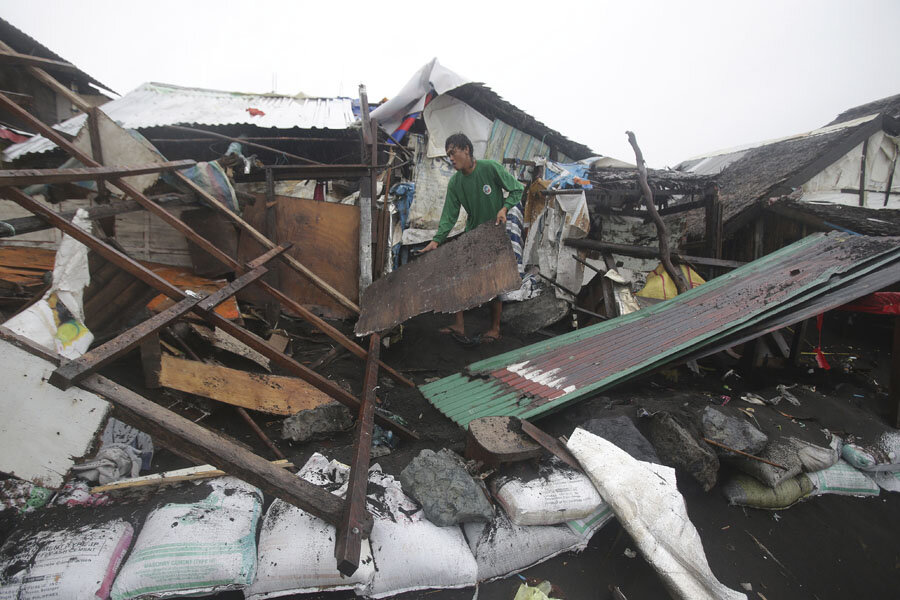At least 21 dead after Typhoon Hagupit strikes Philippines
Loading...
| San Juan, Philippines
Typhoon Hagupit weakened into a tropical storm Monday after leaving at least 21 people dead and forcing more than a million into shelters, while sparing most of a central Philippine region still reeling from last year's monster Typhoon Haiyan.
Hagupit made landfall shortly before nightfall in the resort town of San Juan in Batangas province, 60 miles south of Manila, the capital, with maximum sustained winds of 53 miles per hour and gusts of 62 mph. But a few hours later, Manila still was experiencing only slight winds and light rain.
Forecasters, however, said Hagupit could still generate storm surges that could overwhelm coastal villages. In the capital, police officers were asking people to stay away from a promenade beside Manila Bay for safety reasons.
More than 2,800 villagers moved to emergency shelters in San Juan, a low-lying and flood-prone town popular for its beach resorts, including 220 people huddled inside a gymnasium as torrential rains pounded.
"It's really scary if you've watched what happened during Haiyan," said Amy de Guzman, a 34-year-old mother of three who sought refuge in the gymnasium. "I hope the storm blows away from here as far as possible."
While officials expressed relief that the typhoon had not caused major damage in Tacloban and other central cities that were devastated by Haiyan, they warned that it was still barreling across the southern tip of the main northern island of Luzon, where Manila is located. The storm was expected to blow away Tuesday into the South China Sea.
Hagupit (pronounced HA'-goo-pit), which first made landfall in Eastern Samar late Saturday, was moving slowly at 6 mph and could dump heavy rain that could possibly trigger landslides and flash floods, according to forecasters.
Many of those in eastern areas who evacuated to shelters started to troop back home after the typhoon had blown past their provinces, Philippine Red Cross Secretary-General Gwendolyn Pang said.
Manila Mayor Joseph Estrada said more than 5,000 residents of a shantytown on the edge of Manila Bay have been evacuated due to possible storm surges. Sandbags were stacked along a portion of a seawall to prevent possible storm surges in Manila Bay from spilling into a scenic boulevard and a tourist belt of restaurants and hotels.
"We've prepared and trained for this," Estrada told The Associated Press, adding that his greatest fear was widespread flooding. Metropolitan Manila has a population of more than 12 million people.
Like villagers in the central Philippines, Estrada said Manila residents were readily moving to safety because of haunting memories of Haiyan.
The strongest typhoon on record to hit land, Haiyan's tsunami-like storm surges leveled entire villages and left more than 7,300 people dead or missing in November last year.
Hagupit left at least 21 people dead, including 16 villagers who drowned in Eastern Samar province, where the typhoon made its first landfall, according to the Philippine Red Cross. The government disaster-response agency has reported only five other deaths, including three people who died of hypothermia, saying it was still verifying other reported casualties.
Displaced villagers have been asked to return home from emergency shelters in provinces where the danger posed by the typhoon had waned, including Albay province, where more than half a million people were advised to leave evacuation sites.
Nearly 12,000 villagers, however, will remain in government shelters in Albay because their homes lie near a restive volcano.
President Benigno Aquino III has decided to cancel a trip to South Korea, where he and other Southeast Asian heads of state were to attend a diplomatic summit later this week, so he can deal with the storm's aftermath. He will send two Cabinet members to represent him at the event, presidential spokeswoman Abigail Valte said.







